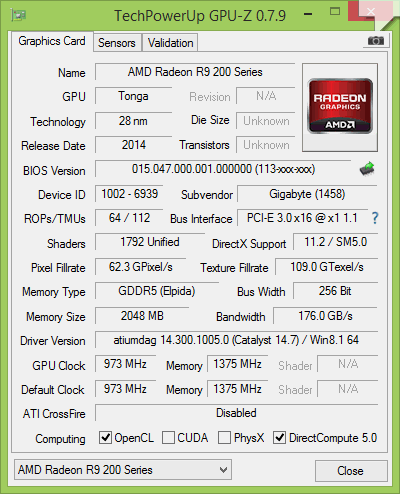AMD Radeon R9 285 Review: Tonga and GCN Update 3.0
On paper, the new Tonga-based R9 285 looks to be slightly slower than the R9 280 it is intended to replace, but there's more than meets the eye.
Why you can trust Tom's Hardware
Gigabyte R9 285 WindForce OC
Another board partner graphics card will serve as the basis for our power consumption and temperature measurements going forward. The Gigabyte R9 285 WindForce OC comes overclocked to 973 MHz from the factory.
| Gigabyte R9 285 Windforce OC | |
|---|---|
| Dimensions | 250 mm (L) x 120 mm (H) x 38 mm (D) |
| Weight | 609 g |
| Form Factor | Dual Slot |
| PCIe | 2x 6-Pin |
| Connectors | 1x DVI-I (Dual Link, + analog)1x DVI-D (Dual Link)1x HDMI1x DisplayPort |
The relatively light graphics card uses the new WindForce cooler with only two fans, which have a larger diameter of 96 mm and fan openings with a diameter of 103 mm.
The cooler and board also represent an interesting new design. The voltage converters are now located near the back of the card, as opposed to the area close to the PCIe power connectors. The aluminum cooler has three parts and uses two 8 mm heat pipes that run through its center to transport waste heat to the two side sections.
We see that the power converters have their own separate aluminum cooler and aren’t connected to the bottom of the main cooler. The airflow is supposed to go through the fins of the main cooler and reach all the way down to the other cooler. We’ll see later if, and how well, this might work.
The top of the Gigabyte R9 285 WindForce OC is dominated by the two 6-pin PCIe power connectors, which have been turned to face toward the board. This perspective also provides a good overview of the cooler’s design.
The end of the graphics card affords a good view of one of the two large heat pipes made of composite material. The orientation of the cooler’s fins shows the direction of the airflow from the board to the top of the card.
The connectors are standard fare. Details can be found in the table above.
Get Tom's Hardware's best news and in-depth reviews, straight to your inbox.
Current page: Gigabyte R9 285 WindForce OC
Prev Page Asus Strix Radeon R9 285 Next Page Test Setup and Benchmark SuiteDon Woligroski was a former senior hardware editor for Tom's Hardware. He has covered a wide range of PC hardware topics, including CPUs, GPUs, system building, and emerging technologies.
-
JeanLuc The idle power consumption numbers are odd, the previous generation cards use less then at idle didn't they? Not that 15 watts is going to break anyone's bank account but its strange nether the less.Reply
Good to see AMD have tackled the noise and temperature issues that have plagued it's previous 28nm cards as well but it's a bit late in the day given that 20nm shouldn't be to far off now. -
gear999 Really nice article guys. I'm impressed by how the 285 actually was able to keep up with the 280. And I'm shocked by the fact that The $250 Nvidia card loses to a $170 AMD card. Thank god I bought a GTX 770 :PReply
Also, on the last page, you guys wrote R7 270X instead of R9, and in the chart it says "Relative to Radeon HD 7950 Boost". Oh, and in the Pros section, it says the 285 has R9 260 like performance?
Thanks for the proofread, fixing it now! :) -
Mike Stewart wow ! at 250$ it actually is a better card even than 280X !! and it was meant for 760....but as it shows here even a 270X is a WAY better card than 760....Reply -
tomfreak Had the tonga 285 come with a 6GHz/7Ghz GDDR5 & 4GB VRAM, the result will be a lot different. Whats with AMD putting on a 5500 memory? facepalm.jpgReply -
srap While this is really a third GCN iteration, showing it as a version number of 3.0 (as in: "Tonga and GCN Update 3.0") makes no sense for me.Reply -
Amdlova some one write this with a .45 acp on the head. I see some error on numbers models etc...Reply
I prefer get a r9 280 and downclock get same results. I can't see the point of this heat on graphics. maybe drivers. OR THIS IS HAWAII XT! Too much Heat! -
Amdlova ReplyI wanted to see the GPU die and OCing results. :(
I think the guys see if they hit the OC the room Will burn! maybe a problem with drivers.
Last time i see that Heat 290x tests. lol! -
Gillerer On the first page, it says "Improvements are always welcome but with the memory interface cut in half compared to the Radeon R9 280,...".Reply
But in fact, the memory interface was cut by a third (384 bit -> 256 bit), not half.
Good point, fixed! Thx.









